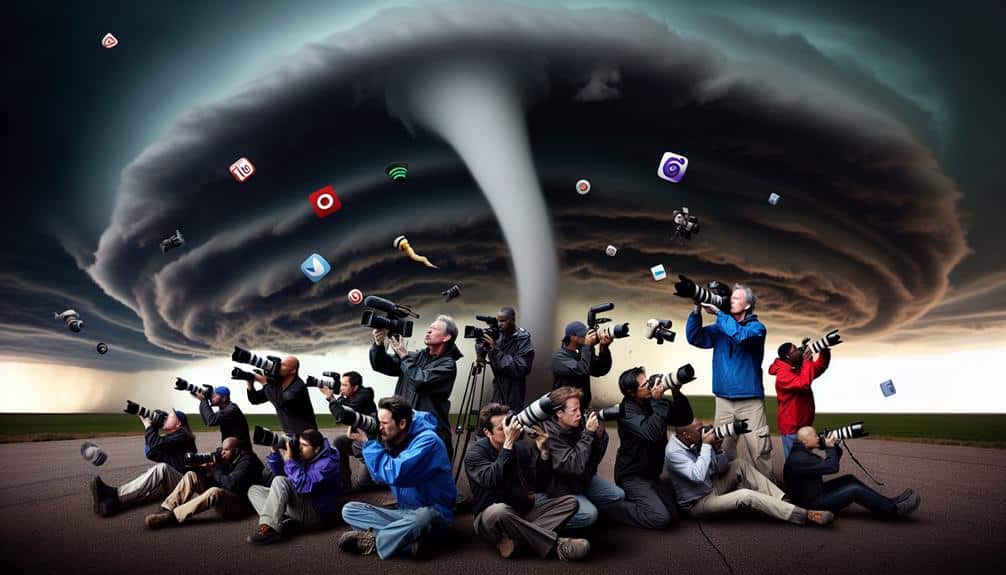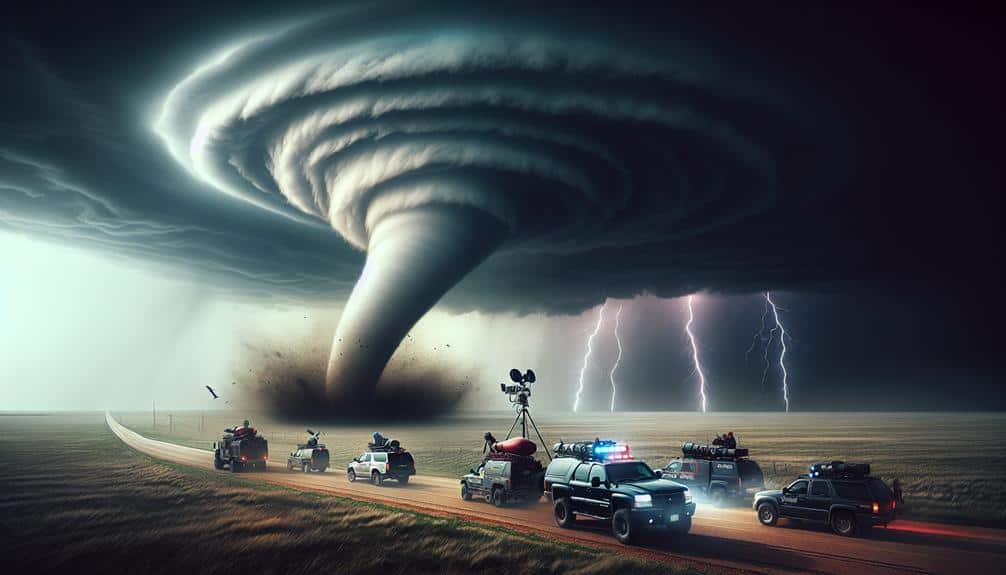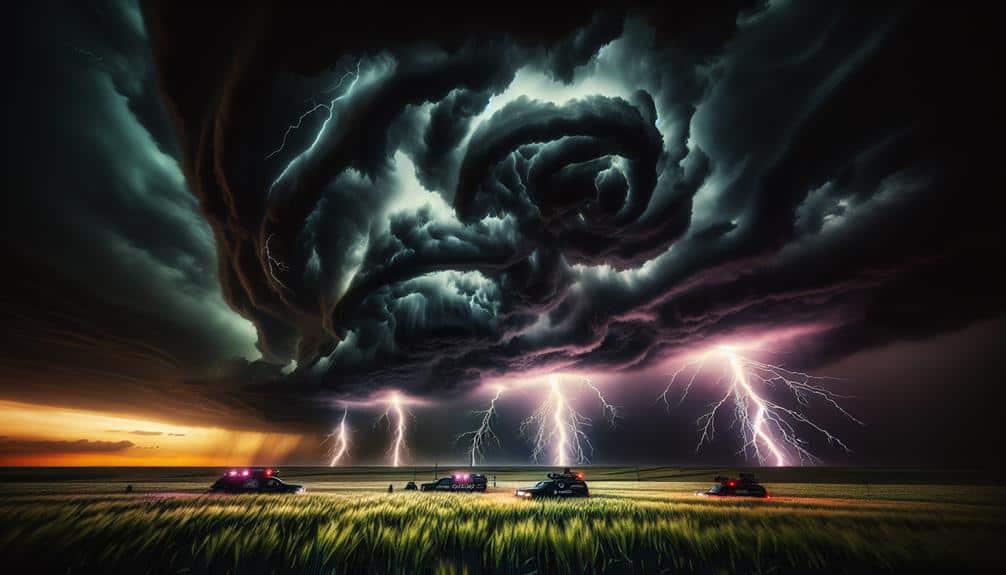In this extensive guide, we explore the best storm chasing competition documentaries that fuse scientific accuracy with cutting-edge meteorological strategies. Titles like *Twister: Anatomy of a Tornado* and *Into the Storm* employ Doppler radar, UAVs, and high-speed cameras to capture real-time tornado formation and supercell dynamics. These films highlight key moments where advanced technology and data collection intersect with the sheer power of nature. Through intricate storytelling and high-resolution visuals, filmmakers enhance our understanding of atmospheric phenomena and safety protocols. For those seeking in-depth knowledge, our guide will provide further insights into these compelling documentaries.
Key Points
- Explore the advanced meteorological techniques and equipment used in storm chasing competitions, including Doppler radar and UAVs.
- Learn about the thrilling rescues and timely interventions enabled by real-time data and satellite imaging in storm chasing documentaries.
- Discover how filmmakers capture and narrate the chaotic nature of supercell thunderstorms with high-speed cameras and dynamic visuals.
- Understand the impact of storm chasing documentaries on public awareness and the storm chasing community's safety measures and collaboration.
Famous Storm Chasing Documentaries
Among the most renowned storm chasing documentaries, *Twister: Anatomy of a Tornado* and *Into the Storm* provide detailed meteorological analyses and real-time data on tornado formation and behavior. These films offer us a unique blend of scientific precision and exhilarating visuals, capturing the raw power and unpredictable nature of tornadoes.
*Twister: Anatomy of a Tornado* is particularly noted for its controversial depictions of storm chasers risking their lives for data. While some criticize the sensationalism, the documentary's thrilling captures of tornadoes underscore the importance of understanding these formidable natural phenomena. The use of Doppler radar and other advanced meteorological tools in the film allows us to appreciate the complexities involved in storm prediction and analysis.
In contrast, *Into the Storm* focuses on the historical perspectives and intense encounters experienced by storm chasers. With a data-driven approach, this documentary meticulously details the sequence of events leading to significant tornado outbreaks. It combines real-time footage with expert commentary, offering an unparalleled insight into the behavior of supercells and the formation of tornadoes.
Both documentaries serve as essential resources for those of us passionate about the freedom to explore and comprehend the forces of nature, while also grappling with the ethical considerations and risks inherent in storm chasing.
Key Moments in Storm Chasing Films
Key moments in storm chasing films frequently highlight the intersection of advanced meteorological techniques and the raw, unpredictable power of weather phenomena. We often witness thrilling rescues, where storm chasers utilize state-of-the-art Doppler radar and satellite imaging to predict tornado paths, enabling timely evacuations and life-saving interventions. The intense emotions during these operations are palpable, as split-second decisions can mean the difference between safety and catastrophe.
In a data-driven analysis, scenes featuring unpredictable weather and close calls stand out. High-resolution footage captures the chaotic nature of supercell thunderstorms, with wind speeds exceeding 200 miles per hour, and hailstones the size of baseballs. These visuals underscore the critical role of meteorological precision. For instance, when storm chasers deploy mobile mesonets and unmanned aerial vehicles (UAVs) to gather real-time atmospheric data, we see the practical application of atmospheric science in action.
Our experience of these films is heightened by the sheer unpredictability of weather events. The tension builds as chasers track evolving storm systems, often narrowly escaping danger themselves. These key moments not only demonstrate the technical prowess of storm chasers but also celebrate the exhilarating freedom that comes with confronting nature's most formidable forces.
Filmmakers Behind the Competitions
Leading the charge in capturing the intense world of storm chasing competitions, filmmakers employ cutting-edge cinematography techniques and sophisticated meteorological equipment to deliver an immersive viewing experience.
Behind the scenes, the challenges faced by these filmmakers are both technical and environmental. Operating in extreme weather conditions, they navigate high winds, heavy rain, and unpredictable tornado paths, all while maintaining the integrity of their equipment.
Our creative process begins with meticulous planning, utilizing satellite data and Doppler radar to predict storm behavior. This data-driven approach informs our shooting schedule and positioning, optimizing the chances of capturing pivotal moments.
High-speed cameras, drones, and mobile weather stations are integral to our toolkit, providing dynamic visuals and real-time data.
Storytelling techniques are paramount in transforming raw footage into compelling narratives. We use a combination of first-person perspectives and wide-angle shots to convey the scale and ferocity of storms. Interviews with storm chasers and meteorologists add depth, offering insights into the human element behind the science.
Impact on Storm Chasing Community
The captivating stories and cutting-edge techniques used by filmmakers greatly influence the storm chasing community by enhancing public awareness and fostering a deeper appreciation for meteorological science. We've seen how documentaries showcasing extreme weather phenomena can ignite interest in atmospheric studies while simultaneously reinforcing essential safety measures among enthusiasts.
Using high-resolution radar data, drone footage, and real-time telemetry, these films provide us with unparalleled insights into storm dynamics. This data-driven approach not only captivates the public's imagination but also educates the community about the latest advancements in storm tracking technology.
By highlighting these innovations, we establish strong community connections, connecting amateur chasers with experienced experts and meteorologists, thereby promoting a collaborative environment.
Furthermore, the focus on safety measures within these documentaries can't be overstated. They educate us on deploying state-of-the-art tracking systems, emergency protocols, and risk assessment models. Such information is critical, as it empowers us to pursue our passion without compromising our safety.
Essentially, these films serve as both educational tools and community-building platforms, enabling us to explore the grandeur of storms while upholding strict safety standards. Through this combination of education and community engagement, we continue to push the boundaries of what's achievable in storm chasing.
Where to Watch Storm Chasing Documentaries

We can access storm chasing documentaries through various streaming platforms, including Netflix, Amazon Prime, and specialized meteorological channels like The Weather Channel. These platforms offer a plethora of options, ensuring we can explore into the atmospheric phenomena and the thrill of storm chasing whenever we desire.
For a more curated experience, we might also consider attending film festivals that specialize in meteorological or environmental documentaries. These festivals often showcase the latest and most groundbreaking work in the field, providing an in-depth look at the science and artistry behind storm chasing.
To optimize our viewing experience, we've identified three key avenues:
- Streaming Platforms:
- Netflix and Amazon Prime offer a range of storm chasing documentaries, often highlighting both scientific analysis and personal narratives.
- Specialized Channels:
- The Weather Channel provides documentaries with real-time data and expert commentary, enhancing our understanding of meteorological events.
- Film Festivals:
- Attending events like the Environmental Film Festival in the Nation's Capital or the Wild & Scenic Film Festival gives us access to exclusive premieres and expert panels.
Frequently Asked Questions
What Safety Measures Do Storm Chasers Take During Competitions?
We implement emergency protocols and wear protective gear to minimize risk. By analyzing meteorological data and maintaining constant communication with our team, we guarantee we're prepared for any hazardous conditions while still experiencing the freedom of the chase.
How Do Storm Chasers Prepare for Documenting Extreme Weather Conditions?
We prepare like navigators charting unknown seas, ensuring emergency protocols and communication systems are robust. Our weather forecasting and research involve analyzing meteorological data with scientific precision to document extreme weather conditions while maintaining safety and freedom.
Are There Any Ethical Concerns Associated With Storm Chasing Competitions?
We must assess the environmental impact and participant safety in storm chasing competitions. Privacy concerns and exploitation risks also require scrutiny to guarantee ethical standards. Data-driven analysis is essential for minimizing negative consequences while preserving our freedom.
What Equipment Is Essential for Filming Storm Chasing Documentaries?
For filming, we need a sturdy camera setup for high-resolution captures and drones for aerial perspectives. Incorporating GPS, anemometers, and stabilized mounts guarantees precise data collection and dynamic drone footage, enhancing our documentary's visual and scientific accuracy.
How Has Technology Advanced the Field of Storm Chasing Documentation?
In the blink of an eye, technology's revolutionized storm chasing. We now utilize drone footage for aerial perspectives and real-time tracking systems to monitor storms, providing unprecedented data accuracy and freedom for our documentation efforts.


